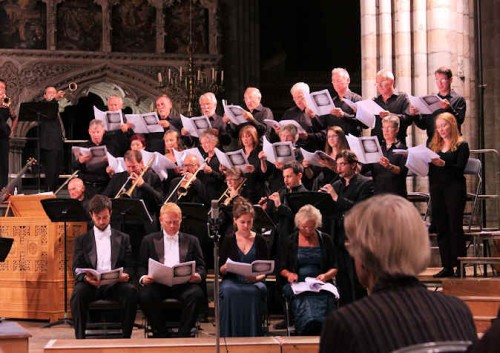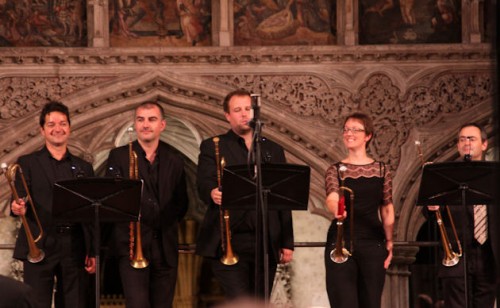 United Kingdom Muffat, Fux, Schmelzer, Priuli, Biber, Rosenmüller and Froberger: Soloists, English Cornett and Sackbut Ensemble, Monteverdi String Band, Altenburg Ensemble, BEMP Singers / JanJoost van Elburg (conductor), Exeter Cathedral, 30.8.2013 (BK)
United Kingdom Muffat, Fux, Schmelzer, Priuli, Biber, Rosenmüller and Froberger: Soloists, English Cornett and Sackbut Ensemble, Monteverdi String Band, Altenburg Ensemble, BEMP Singers / JanJoost van Elburg (conductor), Exeter Cathedral, 30.8.2013 (BK)

Photo (c) Geoffrey Bass
Georg Muffat – Missa in Labore Requies (1687), 1st UK Performance
Johann Fux – Missa Sanctissimae Trinitatis (1693), 1st UK Performance
Other works by G.E.Schmelzer, G. Priuli, H.I. Biber, J. Rosenmüller, J.Pezel, Georg Muffat and J.J Froberger.
Devon’s Blackdowns Early Music Projects (BEMP), led by the apparently indomitable Catherine and Geoffrey Bass, has turned out some remarkable performances over a ten year history and continues to attract experienced singers from the UK and Europe to work with specialist music directors and instrumentalists in programmes of infrequently heard Renaissance and Baroque music. This concert was their largest production to date and offered the first UK performances of two major choral works from 17th century Salzburg and Vienna. A cathedral setting was chosen in order to imitate the sonorities of the original Austrian acoustic as accurately as possible. Both are works little known even among the specialised Early Music community and the smaller of them, JJ Fux’s Missa Sanctissimus Trinitatis was presented in a new edition prepared by BEMP’s Musical Director JanJoost van Elburg specially for its first outing in Amsterdam in 2012. Georg Muffat’s larger Missa In Labore Requies – apparently the composer’s only surviving choral work – was hardly any more familiar, although a recording of it – coupled with HI Biber’s Litaniae Sancto Josepho – was in the German Harmonia Mundi catalogue for a while (HMC 901667) before being withdrawn.
To set these large scale choral pieces in a reasonable historical and geographical framework, the programme’s first half presented items performed by either the BEMP Choir and the Continuo group or by the visiting instrumental groups, followed by the Fux Mass brought to life by the choir, the visiting soloists and the Monteverdi String Band, the Sackbuts and continuo. In the second half, the Muffat Mass’s sections were presented in order but were also separated by items from the Altenburg Ensemble and by Steven Devine on organ. The final sections of the Mass – the Sanctus and Agnus Dei – were gloriously performed by the complete ensemble.

Photo (c) Geoffrey Bass
‘Glorious’ is in fact, probably exactly the right word to sum up this concert. The Altenburg Ensemble’s opening ‘Arie Balletto a Cavallo’ by G.E Schmelzer was a real ‘horse ballet’ performed in Vienna in 1667 for the marriage of Emperor Leopold I to Margareta of Spain according Katie Hodges, one of the group’s clarino players in her nicely descriptive programme note. The ballet’s dances set the tone for all that was to follow and demonstrated the group’s extraordinary virtuosity. The ensemble’s instruments are all wholly ‘natural’ without valves or finger holes and depend completely on the player’s embouchure and breath control for pitch and expressiveness. They can however produce a surprising range of sounds including some that are particularly gentle and beguilingly soothing when the instruments are played con sordino.
After contributions from the Choir and other featured artists – the Monteverdi String Band and the English Cornett and Sackbut Ensemble – came the Fux Mass. Though probably a fairly unfamiliar name to most of us, Fux is reasonable well-known in one important regard: he wrote and compiled the famous Gradus ad Parnassum, a treatise on composition used subsequently by both Haydn and Beethoven. The Mass itself really should be better known. Compared with what would follow after the interval it is a relatively small piece, but it is sensitively scored for double choir which reveals a deep respect for contrapuntal Renaissance influences from Palestrina whilst also looking forward to a contrasting baroque style of composition in the solo writing.
After the interval we heard Georg Muffat’s startling and evocative Missa In Labore Requies Mass of truly impressive proportions. It requires five separate choirs, three of them instrumental and the other two vocal. The vocal choirs are each augmented by four of the eight vocal soloists and a chamber organ making 32 parts in all. Further colour and tonal grandeur are added by the continuo theorbo and violone. It is a huge work, probably only comparable with H. I. Biber’s 53 part Salzburg Mass and according to Geoffrey Bass’s informative programme notes, some recent musicologists have characterised Muffat as the ‘missing link’ between Praetorius and JS Bach. It is fairly easy to see why. The work is full of interest – much more than could be revealed in the now withdrawn recording – and succeeds in providing what I suspect must be gratifying music for all participants, who without exception responded to JanJoost van Elburg’s carefully judged musical direction with what seemed to be genuinely wholehearted and enthusiastic commitment.
The last accolade though, really must go to Catherine and Geoffrey Bass who somehow managed to assemble a truly stellar cast of singers and instrumentalists. It’s not every day that Exeter can boast having performers who work regularly with the Tallis Scholars, The Sixteen, Stile Antico, The Cardinall’s Musick, Synergy Vocals, The Dunedin Consort, I Fagiolini, Oxford Camerata, Oxford Baroque, Fretwork and Ex Cathedra all under one roof at the same time. Bravo once again BEMP! Bravo indeed!
Bill Kenny